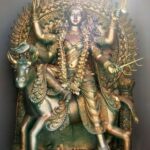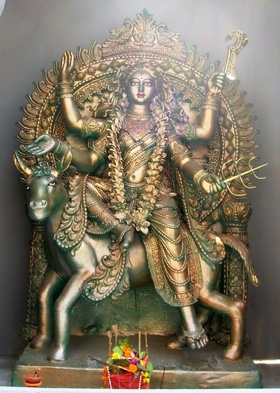
Kālarātri is the seventh of the nine forms of the Goddess Durga, known as the Navadurga.
She is first referenced in the Durga Saptashati, Chapters 81-93 of the Markandeya Purana, the earliest known literature on the Goddess Durga. Kālarātri is widely regarded as one of the many destructive forms of the Mother Goddess, which include Kali, Mahakali, Bhadrakali, Bhairavi, Mrityu, Rudrani, Chamunda, Chandi and Durga.

Ma Kālarātri is the most fierce forms of Durga. Her complexion is dark as night ad has untied bountiful hair. She has four hands and carries a scimitar and a thunder bolt in two of her hands. Other two hands are and the right two are in the varada (blessing) and abhaya (protecting) mudras: ‘giving’ and ‘protecting’. She has three eyes and flames come out of her nostrils when she breathes. Her necklace shines like the Moon shines in the night. Her mount is a donkey.
A form of mother, Kalaratri is extremely frightening to look at but she is always auspicious in effect. This is why she is otherwise known as Subhankari (doing good). So the devotees need not feel any fear from her. On the seventh day of Navaratra the mind of the striver reaches Sahasrara Cakra. For such a striver the door of all Siddhis of the universe start opening.
As a result of her direct vision the devotee becomes quite fit to earn all sorts of virtues. All his sins and obstacles in his way are completely destroyed. He attains the abodes, which are the fruit of inexhaustible virtues.
The mother, Kalaratri destroys the wicked. Danava, Daitya, Raksasa, Bhuta, Preta and all other evil spirits are terrified and run away as soon as the devotee remembers Kalaratri. She is also the remover of planetary evil effects. Her worshipper has no fear from fire, water, wild beings, enemy or night. By her grace he always remains unmindful of any fear. By keeping her form in the heart and meditating on her the devotee must worship her single-mindedly. He should observe all Yamas, Niyamas and Samyamas (all rules and regulations). Purification of mind, words and body is essential in her worship. She is Subhankari. The auspicious effects emanating from her worship are innumerable.
The fifth through the tenth chapters of the Devi Mahatmyam are devoted to the killing of the asuras Shumbha and Nishumbha and their allies. This third section of the epic is devoted to Maha Saraswati. It deals with the overthrow of another most powerful enemy: ignorance of reality or avidya. All our human troubles arise from the fact that we are in total ignorance of who we are, what is happening to us, and what may happen to us. Thus ajñana or ordinary ignorance is the subtle power that really binds us. The mind churns and desires only because we do not know the nature of supreme truth. When the sun of wisdom is covered with clouds, our minds experience a darkness in which the cyclone of desire can sweep us off our feet and project us into a maelstrom of hate and anger. As long as the jivatman is unaware of its own effulgent nature, the tornado of desire will keep blowing.
Human nescience has its root in the three cosmic gunas: tamas, rajas, and sattva. The epic story of the destruction of Shumbha and Nishumbha represents the overcoming and transformation of cosmic nature in the form of these gunas. Sattva is a subtle medium of obstruction. It is like a clear pane of glass that does not obstruct your view but obstructs your approach to the reality within. Psychologically, it manifests as feelings of complacency and satisfaction with what we think we have achieved. Esoterically, these feelings are typified by Shumbha and Nishumbha. Only Maha Saraswati, the power of higher wisdom, can dispel them. Liberation is not an individual effort. It is a cosmiccan endeavor in which we are helped by the great celestial powers. When you step into the spiritual path, you have to leave your petty individual concepts behind and cross into the way of cosmic relationships. A spiritual seeker is not just another individual like millions of others but a special person, for he or she has connected with the universal reality. The Devi Mahatmyam involves us in this cosmic dance that overcomes the powers of tamas, rajas, and sattva and helps us attain supreme realization. In this we are helped by the great forces of Adi Shakti.
Shumbha typifies that part of our nature that keeps resisting the truth that we are all fundamentally the same and all emanate from the supreme. We are confirmed individualists and will not give up our separate egos even if we are promised the kingdom of God. We find it difficult to accept the fact that we cannot force the divine to obey our will. When she doesn't bend to our will, we feel the same frustration and anger as Shumbha. We are allowed full freedom to entertain this idea and combat with her for long time - until the moment comes when she decides that we should be made aware of our true nature.
Shumbha's general Raktabija is an allegory for our unhealthy thoughts, which multiply if left to feed on the negativity that surrounds us. They have to be caught before they take root in our subconscious and multiply beyond our control. Kaali has to be invoked to do this. If left alone, these thoughts will harden into our personality, and then we will never be able to eradicate them. As Swami Shivananda says, "Constant vigilance is the price of spiritual liberty."
The Devi Mahatmyam is the story of an inner battle. Victory comes to us only when we find the strength to surrender our negative emotions to Durga's purifying influence. The different types of conflicts that are described here actually happen daily within our hearts and in the external world. We are constantly waging a war between our negative and positive emotions. It is a battle that has to be fought by every generation. The answers have to be given by the Divine Mother herself. Unless we surrender to her, we can never end the conflict. If, like Chanda and Munda, we try to defy the goddess and usurp her special powers for our own benefit, she become enraged and out of her beautiful form will emanate the terrible figure of Kaali, the power of time, who will devour us with her fierce fangs.
Her planet is Saturn.
Kālarātri Mantra :
Meaning: “She is naked, rides on an donkey, has a long tongue, lustrous body, wears ornaments on her legs like lightning, is black in color, has unlocked hair, big eyes and ears and is very dangerous looking. Meditating on this form of Kalratri removes all obstacles as well as removes all magical effects created by others.”
Oṁ Devī Kālarātryai namaḥ!
ॐ देवी कालरात्र्यै नमः॥